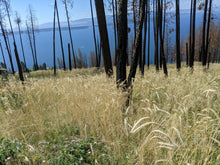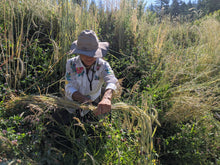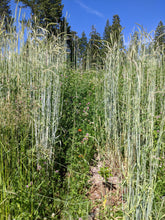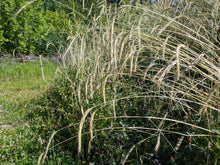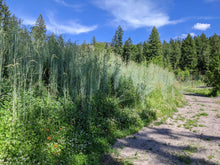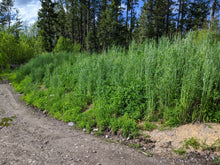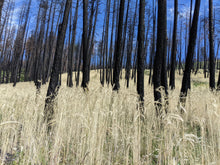Sepp Holzer's Siberian Rye
Regular price
$4.25
Sale
Secale cereale
Origin: Siberia
Improvement status: Cultivar
Seeds per packet: ~70
Germination tested 10/2025: 92%
Life cycle: Biennial
Made famous by renowned permaculture-evangelist Sepp Holzer, this Siberian rye can grow up to six feet tall. Each seed has the potential to grow into a grassy clump that in its second year can feature anywhere from 6 to 22 seed stalks, with each seed stalk hosting a grain head of 40 to 120 seeds. Therefore, under optimal management, one seed can turn into 2,640 grains. Unlike other ancient grains, this rye is extremely easy to thresh on a homescale by using a flail and housefan. Our seed comes from Michael Billington of Nourishing Roots Farm in Montana, who reports that he's never known a more prolific grain.
Although the grain production itself is quite impressive, other features of this grain help make it stand out even more. The long cyan-colored seed stalks make an optimal mulch or animal bedding not only due to their size but also because the long thick structural fibers are not prone to fraying in the same way as wheat, barley or short stalked rye. This means that when spreading animal bedding or mulch, surrounding air doesn't become filled with irritating fibers that get in your eyes, nose, throat, lungs, and clothes. When spread as mulch or bedding, the stalks remain intact for a surprisingly long time.
Siberian rye also lends itself extremely well to landscape revitalization. Its robust and resilient nature, coupled with its extensive root systems and ample production of biomass help to build and protect soils even in harsh or barren conditions. Michael uses this crop for erosion reduction, shading soil and building biomass after constructing extensive earthworks such ponds, terraces or berms. One project took place in a 14-acre post-wildfire zone where the top soil was burned up and washed away. Out of the 60+ species of plants that were reseeded onto the site for remediation purposes, Sepp’s rye established itself more effectively than any other. Of course, it makes a great weed suppressing cover crop, as most other ryes.
There has recently been some confusion over this being called a perennial grain. This is likely due to a translation error. It is an annual grain that can be grown as a biennial. However, when it's frequently grazed by animals, it might persist over multiple winters.
This grain is delicious when cooked whole as a part of soup, as you would with barley or wheat berries. It makes bread that is dark, dense and flavorful (though most Americans are likely to prefer it if some wheat flour is mixed in). This rye makes an excellent sprouted grain to top salads or mix into breads.
GROWING TIPS: To get maximum production of grain in Montana, Michael plants it after the last frost date in spring, about the time as he plants cucumbers. It will also perform well in much of the country planted in late summer or fall. Then the following spring it will set seed stalks and be ready to harvest around July. You can also winter sow it or (depending on your climate) plant very early in the spring to grow it as an annual. The stalks will only be about 3 to 4 feet high using this method. Drill with 4” spacing if growing as an annual.








